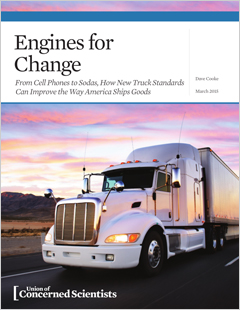Unlike passenger cars and other light-duty vehicles, the fuel economy of heavy-duty vehicles has been largely unregulated for decades. Tractor trailers, delivery vans, and other heavy-duty trucks have kept roughly the same fuel economy since the 1970s—just 6 miles per gallon. Years of non-regulation and slow investment now mean that heavy-duty vehicles consume 25 percent of all fuel, despite only accounting for 7 percent of vehicles on the road.
First-ever standards were finally passed in 2011, putting in place a series of fuel economy targets for different types of vehicles—but more can be done.
Using existing, affordable technology, new trucks could be up to 40 percent more efficient compared to today, reducing annual fuel consumption by billions of gallons and preventing millions of metric tons of global warming emissions. For truckers, fleet operators, and the country’s largest companies—including Walmart, Coke, Pepsi, UPS, and FedEx—a strong federal standard also means good business: annual shipping costs could fall by at least $135 per household, and likely much more.
Trucks impact everyone
From your cell phone to your food to the clothes on your back, nearly every product you use has been on a truck. In the United States, trucks move more than $10 trillion worth of freight every year, consuming over 21 billion gallons of fuel in the process—almost 70 gallons for every U.S. resident.
Even small everyday items have substantial fuel footprints. Cell phones use nearly half a million gallons of fuel to ship every year; shoes and diapers require over 2 million gallons each. Heavier liquid commodities like beer and wine require tens of millions more gallons (62.8 million and 10.9 million, respectively), while it takes over 260 million gallons of fuel to ship fuel itself.
Increasing the fuel efficiency of heavy-duty vehicles would lessen the environmental and economic impacts of shipping these commodities. For the average consumer, stronger standards would translate to fewer global warming emissions associated with the products we use and love, and more affordable shipping as companies realize the cost-saving benefits of using less fuel.
Cleaner fleets, better business
The country’s truckers and fleet operators would also benefit from strong fuel efficiency standards for heavy-duty trucks. Currently, most fleets use fuel surcharges to protect against dramatic spikes in fuel prices. Those surcharges are passed to consumers, affecting product prices and de-incentivizing fleet investment in clean technologies. Over time, lack of investment leads to trucks consuming far more fuel than they otherwise would, hurting the bottom line.
Under strong federal standards, new trucks would use significantly less fuel, limiting fleet exposure to fluctuating fuel prices. Truck drivers would save thousands of dollars a year on fuel with technology that would pay for itself in less than two years. Individual truckers, shipping carriers, and private fleets would all save money: for our largest fleet operators, strong standards would lead to hundreds of millions of dollars in fuel savings every year.
Passing strong standards is a win for consumers, companies, and the environment. Learn more about fleets and the heavy-duty standards by downloading the executive summary or full report, or read our other reports on heavy-duty trucks for further information on technology and the environmental and economic savings of fuel-efficient trucks.




